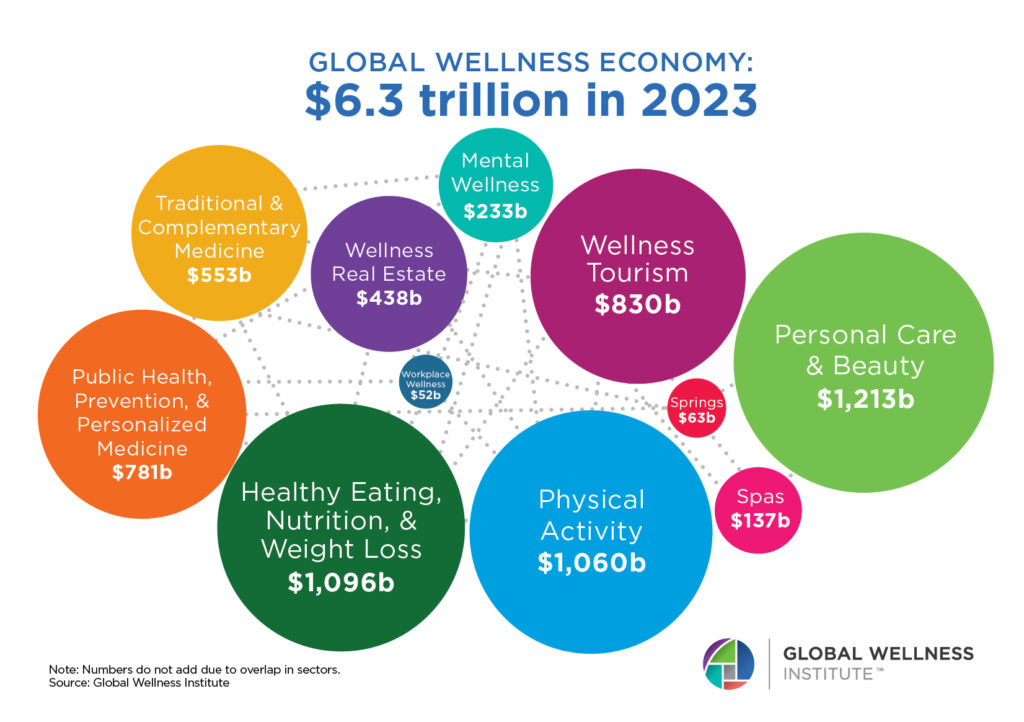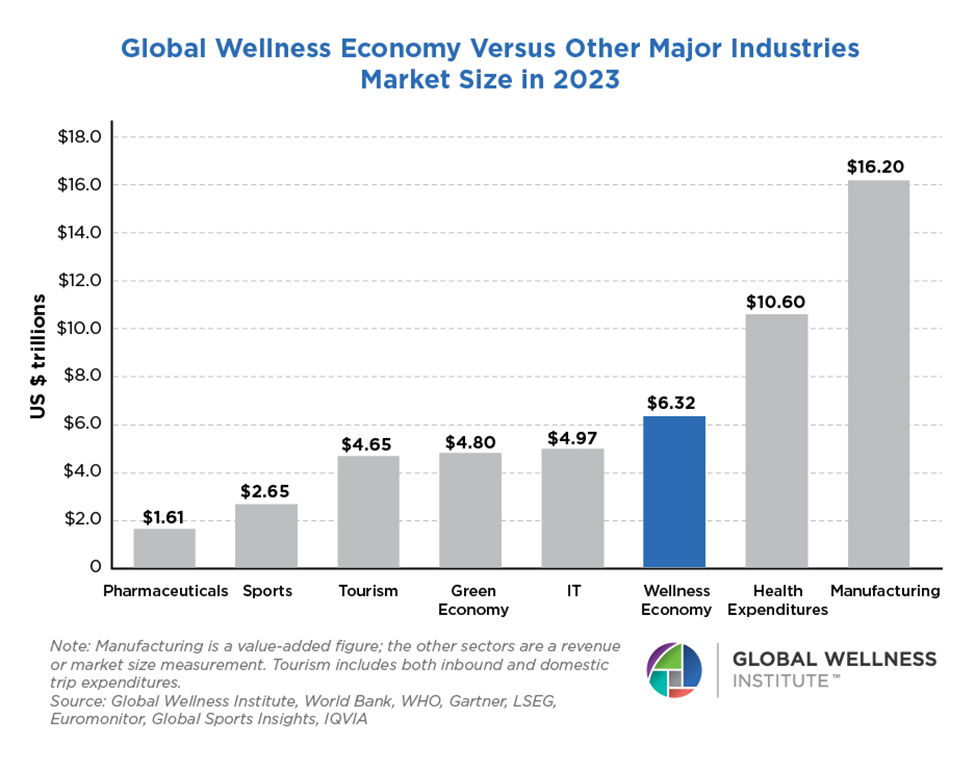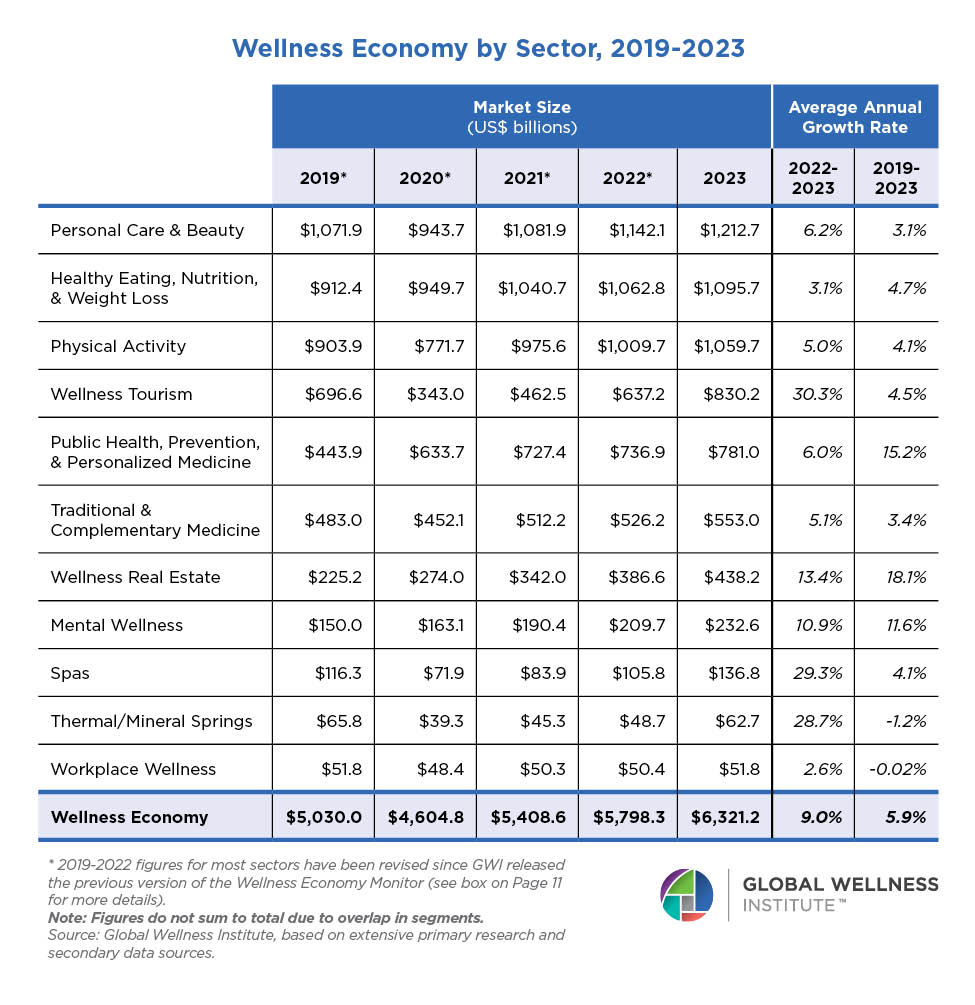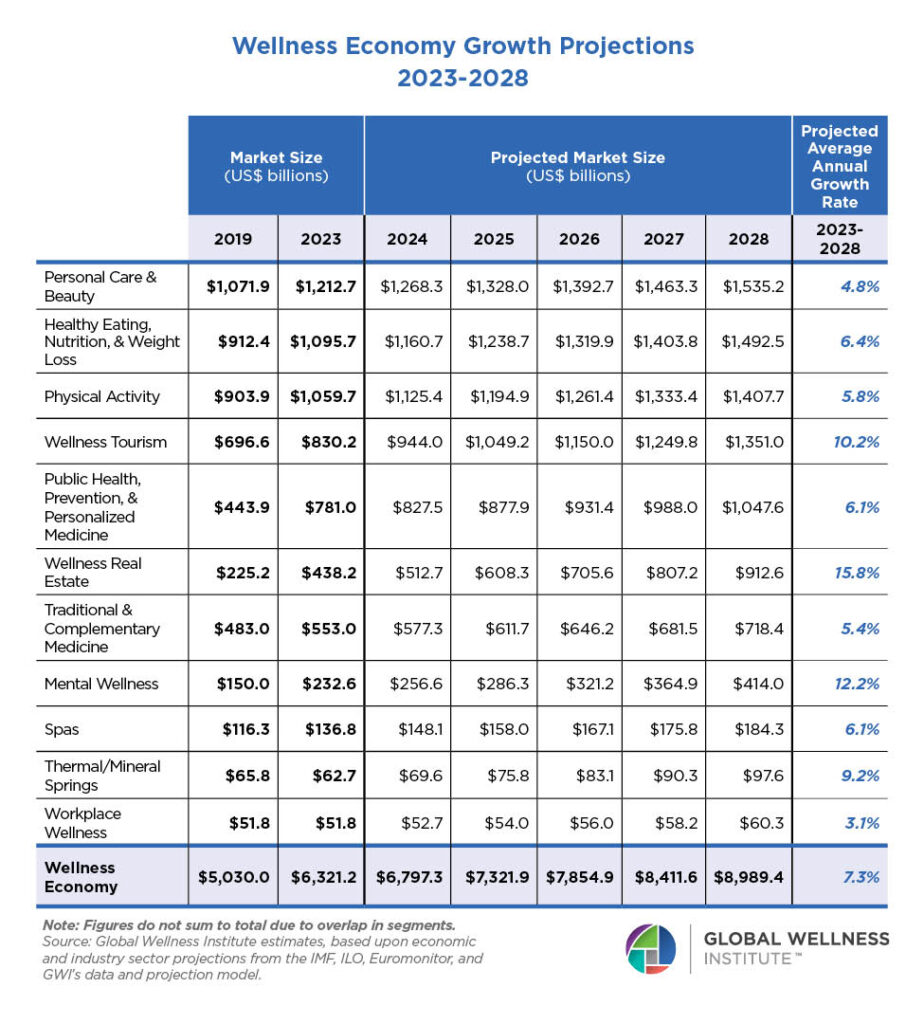Media Contact: Beth McGroarty
[email protected] • +1.213.300.0107
Global Wellness Summit | Global Wellness Institute | Press Image Gallery | Press Release Archive
The Global Wellness Economy Reaches a New Peak of $6.3 Trillion––And Is Forecast to Hit $9 Trillion by 2028
New Global Wellness Institute research reveals a wellness market with relentless momentum, worth 26% more than it was pre-pandemic. The wellness industry is now roughly four times larger than the global pharmaceutical industry ($1.6 trillion) and nearly 60% as big as all consumer health expenditures ($10.6 trillion)

Miami, FL – November 5, 2024 – Numerous global surveys have found that wellness matters more to people each year post pandemic. With today’s release of the Global Wellness Institute’s (GWI) Global Wellness Economy Monitor 2024, there are hard numbers to prove it. The research finds that the wellness market grew from $4.6 trillion in 2020 to $5.8 trillion in 2022, and reached a record $6.3 trillion by the end of 2023 (9% annual growth). Wellness continues to expand its share of the overall economy, now representing over 6% of global GDP, up from 5.75% in 2019.
Wellness markets across every global region have seen strong growth from 2019 to 2023, with North America, Europe, and Middle East-North Africa recording the biggest gains. Market sizes in nine of the 11 wellness sectors have well exceeded their 2019 levels (only thermal/mineral springs and workplace wellness have not yet fully recovered, but will in 2024). The sectors with the most powerful annual growth rates from 2019 to 2023 are: 1) wellness real estate (18.1%), 2) public health, prevention and personalized medicine (15.2%), and 3) mental wellness (11.6%). To provide some context on the rising impact that wellness is having on the world economy, GWI researchers compared it to other vast global industries, finding it’s much larger than the pharmaceutical industry, sports, IT, tourism, and the green economy.
Because the trends fueling the wellness economy will only accelerate—an aging population, chronic disease, widespread mental unwellness—the GWI predicts that the industry will grow a rapid 7.3% annually from 2023 to 2028, when it will represent 6.8% of global GDP. The market will reach nearly $6.8 trillion in 2024 and nearly $9 trillion in 2028 (nearly double its 2019 size).

“The wellness economy continues to march forward at a brisk pace, despite a decline in global wellbeing on many fronts,” said Katherine Johnston and Ophelia Yeung, GWI senior researchers. “In a world full of uncertainty and divisiveness, wellness has become a universal value. No matter your politics or beliefs, who doesn’t desire the knowledge, tools, and opportunities to build a healthy life for yourself and your family?”
The 100-plus-page report is packed with data. It provides new market sizes, recent growth rates, and projections through 2028 for all 11 wellness sectors. It also contains regional data, the top 20 national markets for each wellness sector, and per-capita spending by sector, all while exploring major trends that will impact each segment in the future.
Download the full report HERE.
View snapshots of the 11 wellness markets HERE.
Access graphs HERE.
KEY FINDINGS:

Wellness is now a larger market than many global mega-industries, including IT, sports, and pharmaceuticals. In spite of the rapid growth of green/sustainability businesses, the wellness market is more than 30% larger than the green economy ($4.8 billion). A striking stat: the wellness market is now roughly 60% the size of all global health expenditures ($10.6 trillion).
The Recent Growth Story:

TOTAL WELLNESS ECONOMY: $5 trillion in 2019––$4.6 trillion in 2020––$5.8 trillion in 2022––$6.3 trillion in 2023. Growth from 2022 to 2023: 9%.
All 11 wellness sectors grew from 2021 to 2023. From 2022 to 2023, the sectors with the biggest gains were: 1) wellness tourism (30.3%), 2) spas (29.3%), and 3) thermal/mineral springs (28.7%), a testament to the recent boom in wellness travel, but also reflecting how these sectors suffered the biggest pandemic hits. An even better metric is looking at market growth for each sector since their pre-pandemic level. The top-5 leaders through that lens: 1) wellness real estate (195% of its 2019 level), 2) public health, prevention and personalized medicine (176% of 2019 level); 3) mental wellness (155% of 2019 level), 4) healthy eating, nutrition and weight loss (120% of 2019 level), and 5) wellness tourism (119% of 2019 level).
Wellness real estate has been the growth star before, during and after the pandemic, with consumers and the building industry finally grasping the outsized role that external environments play in our physical and mental health. Also notable: while wellness has historically been a consumer market, the public health, prevention and personalized medicine segment has, since the pandemic, become the fifth largest sector, now accounting for 12.4% of all wellness spending.
Regional Leaders: Wellness markets in every region have grown since the pandemic, but North America (137% of its 2019 market), Middle East-North Africa (130% of 2019), and Europe (125% of 2019) are the three growth leaders through 2023. The largest regional wellness markets are North America ($2.2 trillion), Asia-Pacific ($1.9 trillion), and Europe ($1.7 trillion), which together account for over 90% of the entire global wellness economy. While Asia-Pacific has a far larger population, per capita wellness spending is much higher in North America ($5,768) and Europe ($1,794) than in Asia and other regions.
The Future? Even Brighter:

WELLNESS ECONOMY: $6.3 trillion in 2023–$7.3 trillion in 2025–$9 trillion in 2028. Projected Annual Growth Rate, 2023-2028: 7.3%
The years between 2013 and 2023 could be dubbed “the wellness decade,” the time in which consumer interest and need for wellness became an explosive and permanent shift. The market over that decade grew 6.5% annually. GWI forecasts that from 2023 to 2028, the annual growth rate for the wellness economy will be an even faster 7.3%, substantially higher than the projected global GDP growth rate of 4.8%. The projected growth leaders through 2028 are: 1) wellness real estate (15.8%), 2) mental wellness (12.2%), 3) wellness tourism (10.2%), 4) thermal & mineral springs (9.2%), and 5) healthy eating, nutrition & weight loss (6.4%). The wellness real estate and mental wellness markets will both roughly double by 2028. In that year, for the first time, five segments will surpass $1 trillion in market size: personal care & beauty; healthy eating, nutrition, & weight loss; physical activity; wellness tourism; and public health, prevention, & personalized medicine.
Research Sponsors: This research was made possible by the support of these leading companies: Kohler, Red Sea Global, SIRO, Fountain Life, Biologique Recherche, NADclinic, Carillon Miami Wellness Resort, ESPA, Grown Alchemist, Hyatt, Technogym, Amatrius, Beppu City, Elemis, Mather, Naturopathica, Perfect Wellness Group, Rancho La Puerta, Six Senses and Universal Companies.
About the Global Wellness Institute: The Global Wellness Institute (GWI), a nonprofit 501(c)(3), is considered the leading global research and educational resource for the global wellness industry and is known for introducing major industry initiatives and regional events that bring together leaders to chart the future. GWI positively impacts global health and wellness by educating public institutions, businesses and individuals on how they can work to prevent disease, reduce stress and enhance overall quality of life. Its mission is to empower wellness worldwide.























































